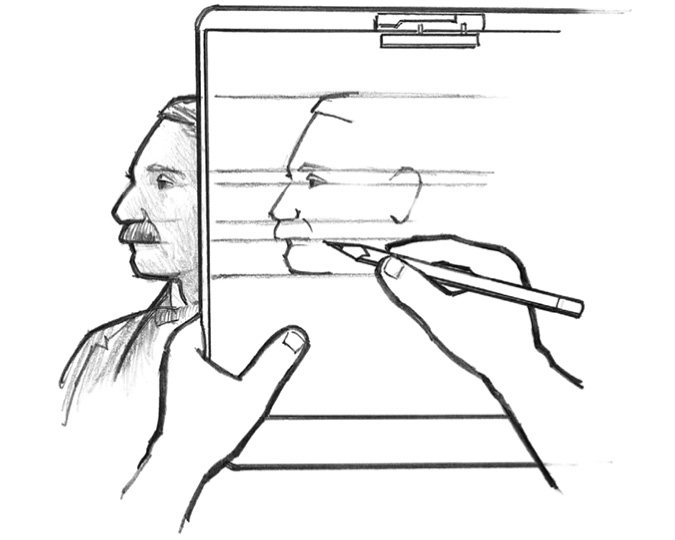
Let the Lines Guide You
Line up your drawing board and paper with your subject and lightly sketch horizontal lines. These will guide you as you place your subject's features. Grab a friend and try it yourself!
Sketching and drawing are two different things. A sketch is a work in progress. You may sketch to observe your subject matter or to resolve questions regarding a drawing you are working on. A sketch may help you understand the values of a subject, or gain more understanding of the subject's structure, proportions and placement of its compositional elements. Sketches like these may progress toward a more finished drawing. On the other hand, (no pun intended!) drawing is an activity that is begun with the intention of producing a finished piece of art.
With these definitions in mind, recognize that there are times to begin a drawing with a sketch and there are times to begin a sketch without any intention of refining it into a finished drawing. As a beginner, if you are trying to do more drawings than sketches, then you may be putting too much pressure on yourself. Loosen up and enjoy learning four different approaches to sketching and drawing: structural line sketching, value sketching, black-and-white sketching and contour sketching.

Line up your drawing board and paper with your subject and lightly sketch horizontal lines. These will guide you as you place your subject's features. Grab a friend and try it yourself!
There are different ways to hold a pencil, depending on what type of strokes and lines you want to achieve. You may start out with loose, sketchy lines and progress to tighter, more controlled lines and shorter strokes. Here are some common hand grips you can try as you sketch and draw. You may find something else that works better for you. You will find that pressure and grip affects the line results of your drawings. Generally, the more pressure you apply, the darker your line will be.
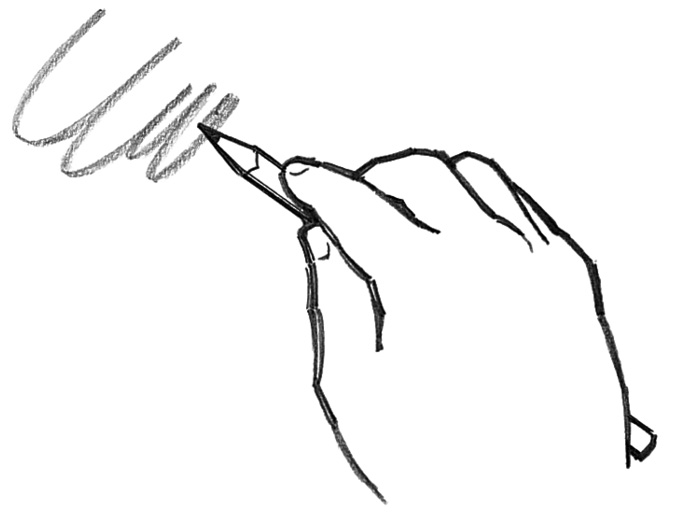
For thick, loose lines, avoid using the point of the pencil. Instead, grip the pencil with your thumb and fingertip so that the pencil lead lies flat against the paper. Your fingertips should be either just above the paper surface or gently resting on it. This may smear your previous pencil lines, so be careful. You will use your entire arm to draw these wide lines.
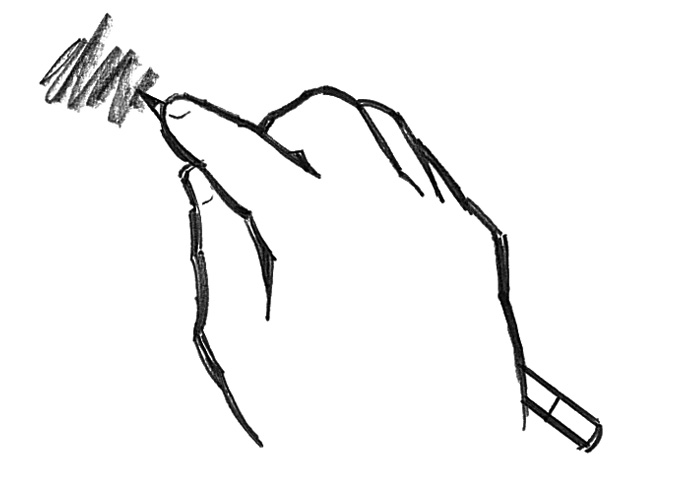
Apply more pressure to the point of the pencil by moving your index finger closer to the tip. Your fingertips may rest on the paper, though it isn't necessary that they do so for this stroke to be successful.
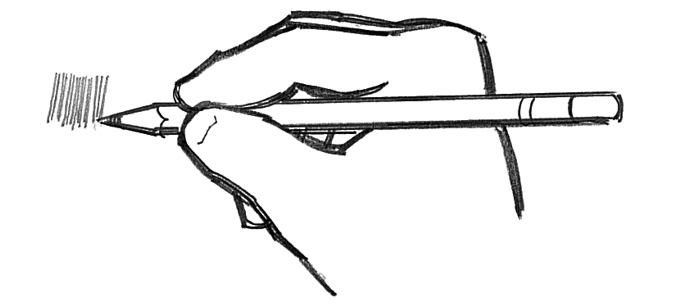
For lines like these, grip the pencil as in a handwriting position, with the pencil resting between your thumb, middle and index fingers. Your hand rests gently on the paper. For very thin lines, the pencil tip needs to come to a sharp point.
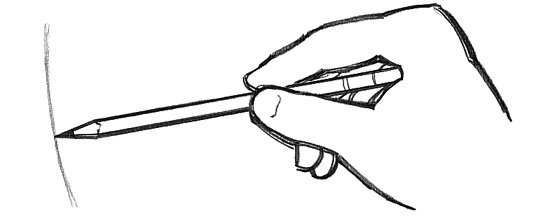
This grip is similar to the handwriting position, except you hold the pencil out at length. Use this grip to achieve wide, straight and arced lines. Let your hand rest gently on the paper.
A piece of paper can be used as a frisket to make an even edge for a set of pencil lines. This is also a great technique to use if you want to create a clean margin for your drawing. This method also works well for backgrounds.
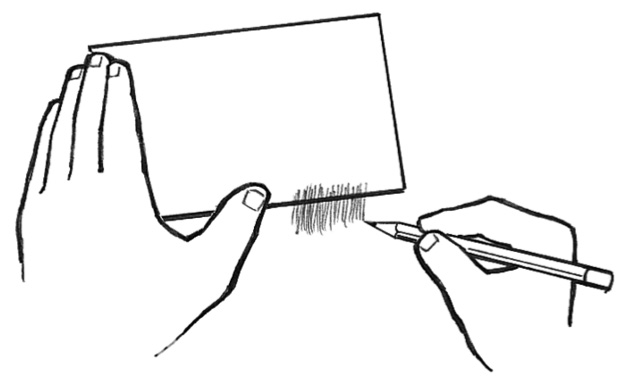
Place a piece of scrap or copier paper over your drawing. Start the line strokes on the scrap paper and continue onto the drawing paper.

Lift your frisket away. The pencil lines should look as if they start from one invisible line.
A structural sketch is the basic linework in which values and details are built upon. They are a great way to observe your subject, and are often used as a basis for a more finished drawing. A structural sketch is also an excellent way to loosen up before doing another type of sketch or drawing.
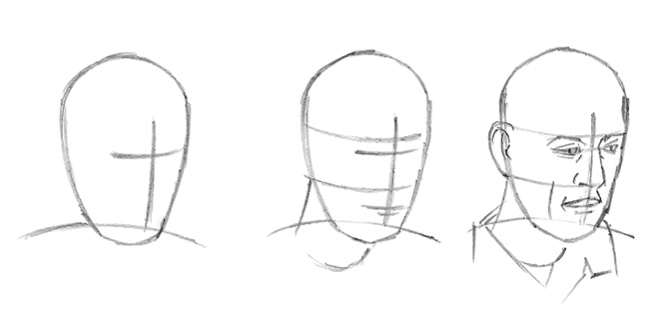
A structural sketch will help you observe and understand the underlying structure of the subject. Here you will focus on the placement and proportions of the elements rather than on light or shadows (see Value Sketches).
A structural sketch helps you see how a subject is constructed. Look for basic shapes such as squares, rectangles and circles. Now ask yourself how they relate to one another. Before you pick up your pencil to sketch your coffee cup, take a minute to study your subject.
4H graphite pencil
Drawing paper
Kneaded eraser
Straightedge (optional for the first step, absolutely prohibited for the rest of the steps)
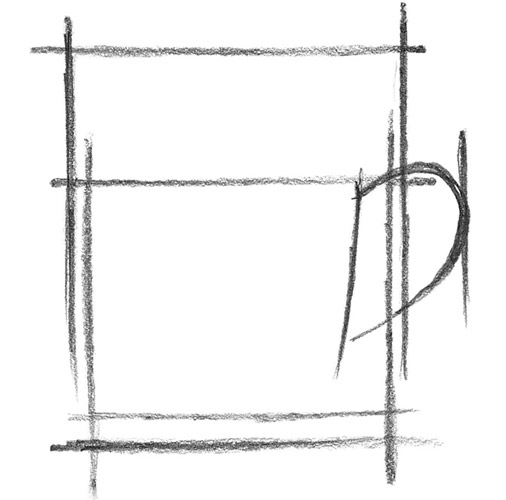
Use a 4H pencil to sketch the outer forms of the mug and the most relevant structural guidelines, such as those that will indicate the placement of the rim, the bottom of the cup and the handle.

Sketch the rim of the cup and the handle. Use the lines you drew in step one to help you add these additional lines. Look for points where elements line up such as the rim of the cup and handle.
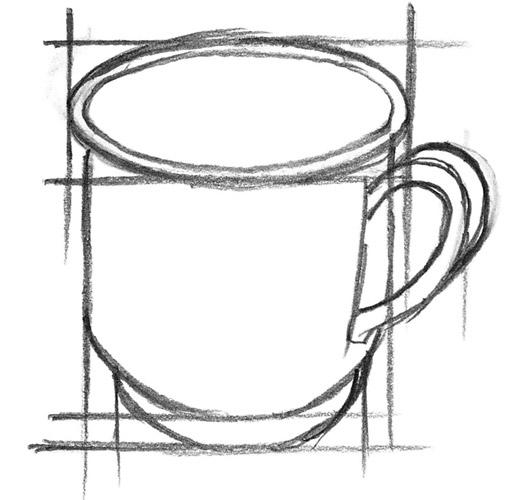
Add details such as the inner lines of the rim and handle. Erase any unnecessary guidelines with a kneaded eraser.
Values are the degrees of lights and darks in a drawing or painting. A value sketch is used to observe a subject without much regard for structural or proportional accuracy. Here you focus on the lights and darks of your subject. One way to visually separate the structural lines from the values is to squint at your subject. This blurs the structural lines and makes the lights and darks more noticeable. For a finished drawing that employs values, it's a good idea to do a structural sketch first to make sure the elements of your subject are in the right places. See Combining Approaches for more explanation.
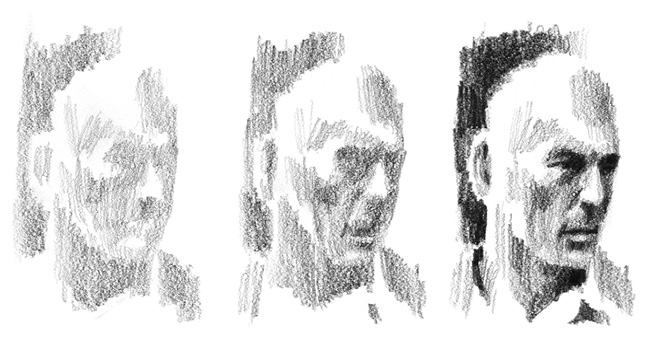
Begin a value sketch by first locating the areas of highlights, which will be left white. Then lightly shade the areas of overall values. The next step is to add more layers of shading for the middle values. Finally, add the darkest shading.
If you want to erase in a specific area of your drawing, use an erasing shield. Place the erasing shield over the region that is not to be erased. Gently begin erasing with a kneaded eraser. Use a white vinyl eraser if the kneaded eraser doesn't fully erase the first time.

In this exercise you will be focusing on values instead of lines. The idea of a value sketch is to define form through light and shadow instead of lines, so use shading to give your coffee cup form. Remember, this is not intended to be a finished drawing, so relax and enjoy the process.
4B graphite pencil
Drawing paper
Kneaded eraser
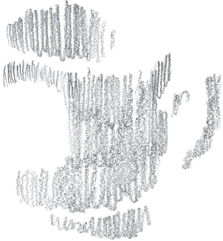
Use a 4B pencil to sketch the lighter values, keeping the lightest ones the white of the paper. Use pencil strokes that feel comfortable for you. They may be vertical, horizontal or even scribbles.

Continue adding layers for the middle values, gradually giving form to the sketch.
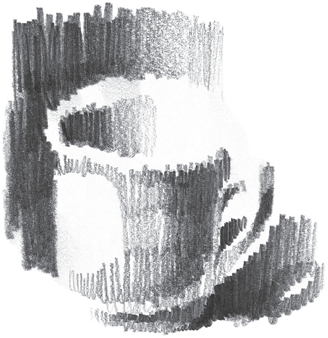
Finish by adding more layers for the darkest values. Use a kneaded eraser to lighten some areas if you think they need it.
Black-and-white sketches are like value sketches, except that you focus on the contrasting blacks and whites and ignore the middle values. Your softest 4B pencil will work, but charcoal and carbon pencils work especially well for this because of their rich, dark qualities. Also called chiaroscuro sketching, this type of sketch is a good exercise for understanding what makes images visually identifiable with the most basic of values, black and white.
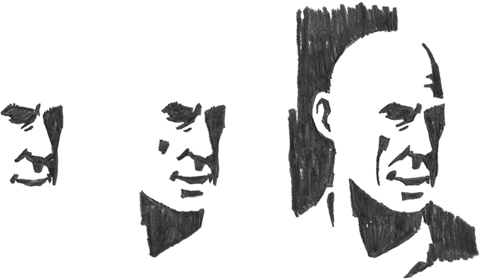
No matter what part of the subject you're drawing, use only black and white forms to define it for a Chiaroscuro drawing.
As you are drawing, your hand glides over the paper surface and can smear the pencil lines. One solution to this is to use a slip sheet, which is a sheet of paper placed between your hand and the drawing surface. This way your hand does not rest directly on the drawing.
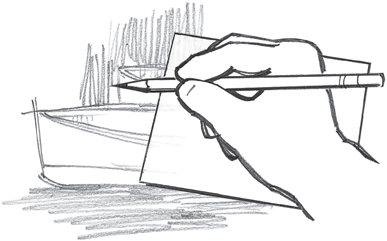
No, it's not a fancy type of coffee, it's a black-and-white sketch of a coffee cup! This is like taking a value sketch to the extreme; no outlines and no middle values will be used to interpret the subject. Use this method to examine a subject's most basic lights and darks.
Remember, this is just a study. Like a sketch, this is not intended to look like a finished drawing.
Anything from a 4B to 8B graphite, carbon or charcoal pencil
Drawing paper
Kneaded eraser

With a soft-lead pencil, sketch the most noticeable darks of the subject. In this case, the interior of the mug, along the rim, and down the right on the outside of the mug are the darkest areas. Keep your pencil strokes close together so areas will look black.
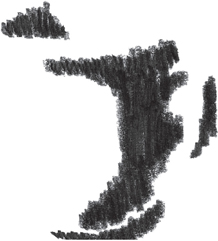
Continue adding darks, using them to define the image.
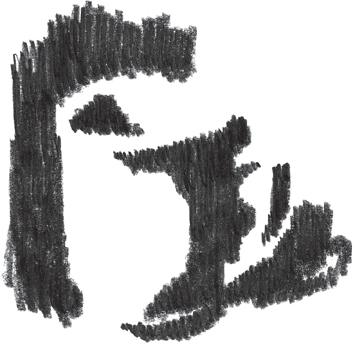
Finish adding darks to complete the mug. Add a background and some shadows to further define the image.
This type of sketch is also called a continuous line sketch because you draw with one continuous line, drawing outlines and defining value areas. Don't worry about accuracy. This is a fun exercise for loosening up before you draw, and it will sharpen your observation skills. Add more of a challenge by blocking your view of the sketch in progress, letting your hand guess at what the pencil line looks like on the paper. This is called blind contour sketching.
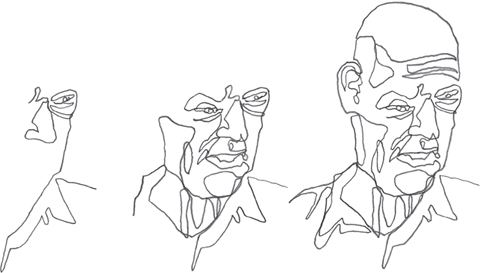
Once you start moving your pencil, don't lift it until the sketch is done.
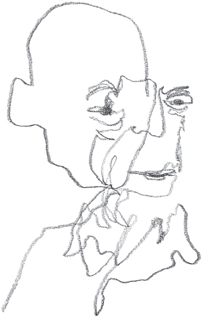
This sketch was done by observing the subject without looking at the drawing paper. Block your view of the sketch with a piece of cardboard until you're finished.
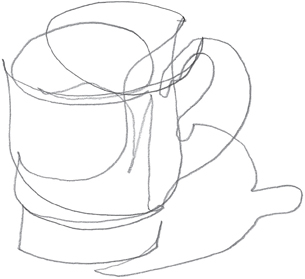
No one expects contour sketches to be identifiable. As Mary worked through this sketch, she gained a real understanding of the contours of her coffee cup.
This sketch is done by placing the pencil onto the paper and not lifting it until the sketch is finished. Look for lines and shapes. Follow the contours that define the subject and the shadows around it. Doing a contour sketch is truly an exercise in putting observation into practice!
HB graphite pencil
Drawing paper
Kneaded eraser
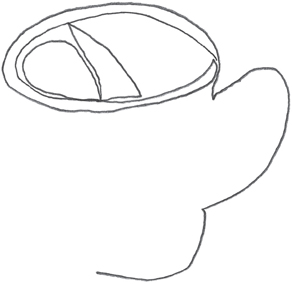
Put an HB pencil to the paper and start moving it, following the contours of the subject without lifting the pencil from the paper.
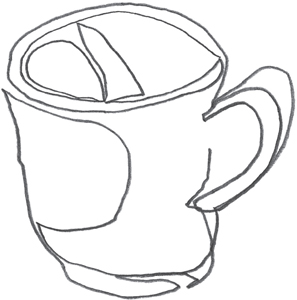
Keep moving the pencil so that the sketch is formed with a single line.

Keep moving the pencil until the sketch is complete.
We've explored four different approaches to sketching and drawing. If you tried the value, black-and-white or contour sketch demos, you might be thinking your art didn't turn out anything like you expected. Do not be discouraged and don't give up! You are already growing in your observation skills.
You can combine some of the different approaches to achieve a more finished drawing. For instance, start with a structural line sketch and then add values. During the structural sketch stage, you should look for the basic shapes (see Using Basic Shapes) and proportions (see Gauging Proportions) so you can be confident of their placement before you add the values.
A light box is a device that allows you to see the structural lines for a drawing without having to draw them on the artwork itself. First, create a structural sketch of your subject. Place the structural sketch on the light box, then tape a piece of drawing paper to the structural line sketch. The image will be visible through the drawing paper to provide a foundation for your value, black-and-white and contour drawings.
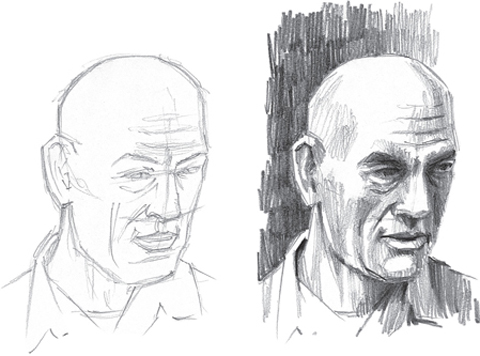
Work out proportions with a structural sketch and placement of the elements in your composition. Add value changes to define form and shadow.
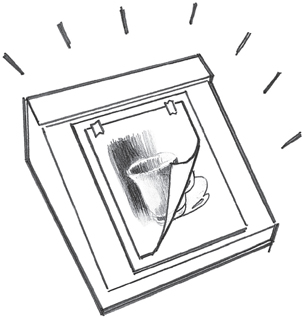
Do a structural sketch of your subject, erase obsolete guide lines and add detail lines defining the form and shadows. Use this sketch as the basis for a value sketch, black-and-white sketch or contour sketch. Place the sketch on a light box and then place your drawing paper on top of the sketch. Turn on the light box so the image of the sketch will be visible through the drawing paper. This will provide a framework for your subject so you don't have to sketch the structural guidelines onto the drawing paper.
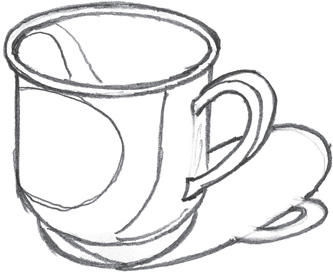
These lines indicate highlights and shadows as well as the structure of the subject. To use other drawing approaches, erase any obsolete markings.
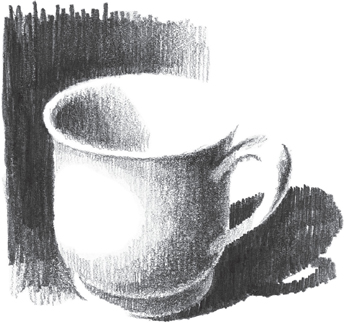
A light box was used to backlight the structural sketch as a guide for this value drawing.

A light box was used to backlight the structural sketch as a guide for this black-and-white drawing.
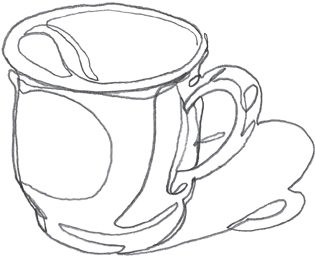
A light box was used to backlight the structural sketch as a guide for this contour drawing.